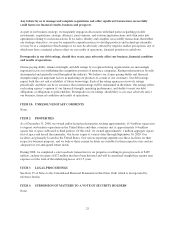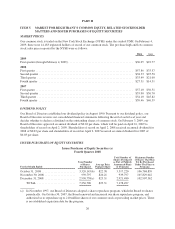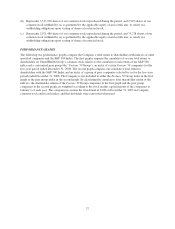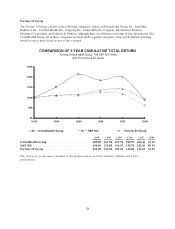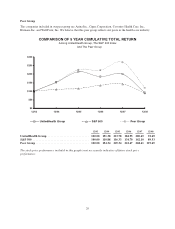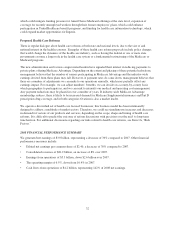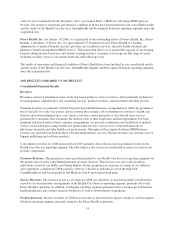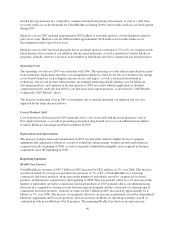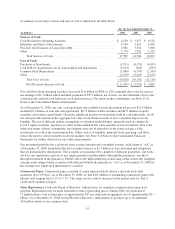United Healthcare 2008 Annual Report Download - page 45
Download and view the complete annual report
Please find page 45 of the 2008 United Healthcare annual report below. You can navigate through the pages in the report by either clicking on the pages listed below, or by using the keyword search tool below to find specific information within the annual report.Investment and Other Income. The decrease in investment and other income in 2008 was primarily due to lower
investment yields primarily as a result of the decrease in interest rates on our cash equivalents, decreased average
investment balances related to lower operating cash flows, decreased deposits held for certain government-
sponsored programs and increased other-than-temporary impairment charges related to the disruption in the
financial markets.
Medical Costs
Medical costs for 2008 increased primarily due to medical cost inflation, acquisitions completed in 2008 and
growth in Ovations Medicare Advantage and Medicare Supplement products, partially offset by a decrease in the
number of individuals served through both UnitedHealthcare risk-based products and Medicare Part D
prescription drug plans.
The medical care ratio, calculated as medical costs as a percentage of premium revenues, reflects the
combination of pricing, benefit designs, consumer health care utilization and comprehensive care facilitation
efforts. Our consolidated medical care ratio increase was primarily driven by premium rates advancing more
slowly than medical costs in 2008 for certain risk-based products in the commercial, senior and behavioral care
markets.
For each period, our operating results include the effects of revisions in medical cost estimates related to all prior
periods. Changes in medical cost estimates related to prior periods, resulting from more complete claim
information identified in the current period, are included in total medical costs reported for the current period.
Medical costs for 2008 included approximately $230 million of net favorable medical cost development related
to prior fiscal years. Medical costs for 2007 included approximately $420 million of net favorable medical cost
development related to prior fiscal years.
Operating Costs
The operating cost ratio, calculated as operating costs as a percentage of total revenues, increased in 2008
primarily due to certain expenses as discussed below, acquisitions completed in 2008, costs for anticipated
revenue growth that did not fully materialize and a change in business mix towards service revenues from
fee-based businesses.
Operating costs for 2008 include $882 million for the proposed settlements of two class action lawsuits related to
our historical stock option practices and related legal costs, net of expected insurance proceeds, and $350 million
for the settlement of class action litigation related to reimbursement for out-of-network medical services,
partially offset by a $185 million reduction in expenses for proceeds from the sale of certain assets and
membership of our individual Medicare Advantage HMO plans in Clark and Nye Counties, Nevada relating to
the Sierra acquisition. These amounts have been recorded in the corporate segment. For a discussion of the
proposed settlements, see Note 15 of Notes to the Consolidated Financial Statements.
Operating costs for 2007 include $176 million of expenses recorded in the first quarter of 2007 related to
application of deferred compensation rules under Section 409A of the Internal Revenue Code (Section 409A) to
our historical stock option practices. The $176 million Section 409A charge includes $87 million of expenses for
the payment of certain optionholders’ tax obligations for stock options exercised in 2006 and early 2007 and $89
million of expenses for the modification related to increasing the exercise price of unexercised stock options
granted to nonexecutive officer employees and the related cash payments. These amounts have been recorded in
the corporate segment. For an expanded discussion of our Section 409A charges, see Note 12 of Notes to the
Consolidated Financial Statements.
35


